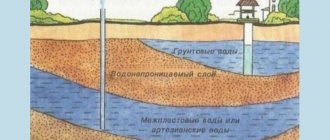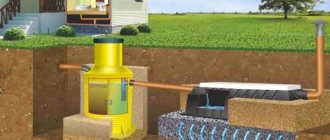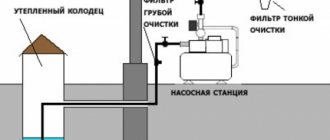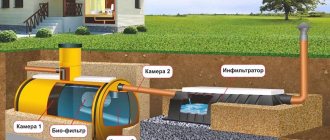Winter is a wonderful time of year, especially in Russia. A sparkling blanket of snow, like a precious holiday decoration, covers the ground, houses and trees. But along with snow and frost, problems come to those who are not prepared for winter, and sometimes very serious ones. Thus, freezing of the water supply threatens the failure of the entire water supply system. Therefore, it is necessary to take care of protecting the pipes even at the stage of building a house, and if this was not done in due time, you need to have time to insulate it before the onset of real cold weather.
What are the dangers of freezing pipes?
As you know, when water freezes it expands. If you pour water into a glass jar and put it in the freezer, after a few hours you will find that ice has formed inside and the jar is cracked. The same thing happens with water pipes - cracks and breaks appear in their walls. After the system defrosts, leaks form in places of damage: water flows out of the formed holes and is absorbed into the ground, gradually forming a flooding zone. At the same time, soil particles enter the water supply system, contaminating the water, which can easily result in an infectious disease or parasitic infestation.
To correct the damage, you have to dig a water supply trench and inspect the entire system. As a rule, in this case, experts advise completely replacing frozen pipes: even if some section of the water supply system looks intact, the resulting microcracks can render it unusable within a couple of years. Therefore, insulating pipes, no matter how expensive it may be, still ends up being a more profitable and reasonable step than repairs that are inevitable after freezing.
How to find a problem area?
The most difficult moment in this matter is to determine the location of freezing in an open section of the water supply system. Experienced craftsmen advise focusing on temperature sensations when inspecting and probing the accessible part of the route.
It is not difficult to determine the location of an ice plug in a plastic pipeline by palpation: within the blocked area, when you try to slightly bend the pipe, a characteristic crunch is heard
Water pipes usually freeze in areas where the pipes come close to the ground. Technical wells and unheated basements are also vulnerable to frost.
It has been noticed that concrete freezes faster than soil layers. Therefore, if the basement was unreliably insulated or was slightly opened during periods of severe frost, it is quite natural that the pipeline running in it froze.
If the freezing area cannot be determined, it is better to immediately abandon the idea of breaking through the ice jam using mechanical methods.
If it is not possible to “calculate” a specific area, use available methods at once on several of the most likely freezing areas.
Basic ways to combat freezing pipes
The problem of insulating communications arose, in fact, with their appearance. Over more than a hundred years of existence of the central water supply, the following methods have been developed to prevent freezing of pipes and have proven their effectiveness in practice:
- constant circulation of water in pipes;
- immersion of the water supply system in the ground below the frost line;
- insulation of pipes with appropriate materials;
- draining water from pipes for the winter (if the house is used only in the summer);
- insulation of the water supply using a heating cable.
Often several methods are used simultaneously. For example, pipes are buried in the ground and wrapped in insulation or heated with cable. Let's look at each method in more detail to find out its pros and cons.
Heating with water circulating in pipes
Where does the water in your home water supply come from? It comes either from a well or from a central water supply. In both cases, its temperature at the entry point is above zero, so it can be conditionally considered warm. If warm water constantly flows through the pipes, then the system cannot freeze, since the liquid warms it up with its heat. In the simplest case, it is enough to leave the tap slightly open to avoid ice forming in the pipes.
Of course, the method only works if you have somewhere to drain the water: into a storage tank, into an insulated central sewer, etc. This problem is often solved by draining the water back into the well or well through a second pipe and a three-way valve.
In addition, it is necessary that the speed of movement of the liquid through the pipes be higher than the speed of its freezing, i.e., so that during its flow through the cold, cooling pipe it does not have time to lose all the heat and turn into ice. The lower the outside temperature, the more water needs to be pumped per unit of time. To control the process, you will need a temperature sensor that will regulate the water supply, turning the pump on and off depending on the temperature.
As you can see, the method of constant pumping is quite expensive and difficult to implement, and besides, it cannot be called sufficiently reliable.
General information
How to insulate street water supply?
Laying a water pipeline two meters deep in the ground does not guarantee that it will not freeze during severe frosts. And under no circumstances should the water inside the structure be allowed to freeze, otherwise it can rupture and damage the entire plumbing system.
Therefore, it is worth taking care in advance about protecting the water supply from freezing outside and choosing the right insulation.
There are two weak points in a home plumbing system.
- The location of the pipeline on the street under a layer of earth.
- The pipeline is located in an unheated room.
If it is easier to insulate the water supply in a private house that is located indoors, then the water supply that is laid outside requires a more thoughtful approach. Basically, it all depends on the quality of the insulation used.
A good insulation for water supply should have the following characteristics:
- low thermal conductivity;
- durability;
- ease of installation;
- resistance to aggressive environments;
- must withstand the operating temperature of the environment;
- fire safety and tightness;
- low price with the possibility of repeated use
Based on these characteristics, the optimal thermal insulation for water supply in a private house is selected. Today there are a large number of insulation materials. Below we will analyze some of them.
Burying water pipes
It makes sense to protect the system from frost by hiding it deep in the ground if the freezing point of the soil lies no deeper than one and a half meters from the surface. The method works great in the middle zone and southern regions. To prevent pipes from freezing, the depth of the ditch for laying them should be 15-20 cm lower than the frost line. The financial costs of implementing this method are not particularly high if you dig a trench yourself.
A deep trench is dug from the water intake well or well to the very wall of the house. The bottom is covered with a 10-centimeter layer of sand, the pipes are protected from deformation by a corrugated casing or placed in a wider plastic pipe, then covered with soil removed from the trench. This is the simplest and cheapest method: a layer of soil lying on top of the pipe serves as protection from frost. But for reliability, it is advisable to wrap the water pipes with insulating material before burying them.
Pipe for external sewerage 110x1000mm
Correct styling
Proper installation will help avoid serious problems such as water freezing, loss of permeability and pipe rupture. The basic requirements are specified in SP 31.13330.2012, which also apply to private housing construction.
Depth
According to building regulations, it is recommended that water pipes be laid below the ground freezing level. Based on the results of long-term observations, special maps or tables are compiled in the coldest months of the year.
The depth of the pipeline depends on the climatic conditions in the region and the composition of the soil at the site. Loams and clays freeze less than sand or rocky soils. So, in the Moscow region this value is in the range from 1.35 to 2 m, in the Krasnodar Territory - 0.3-0.5 m, in Surgut 2.2-2, 9 m.
Slope
When laying, you must strictly observe a reverse slope of at least 0.001 towards the well or insertion point. On flat terrain it can be reduced to 0.0005.
This means that the height difference for each linear meter of length should be at least 0.5-1 mm. Even with such a small slope, the water will spontaneously flow back into the well or main line and will not stagnate, creating conditions for the formation of ice.
Insulation for water supply
If you use a thick layer of insulation, you don’t have to deepen the trench below the freezing point (but it’s still better not to skimp on depth). After laying, the pipes are covered with a heat-saving shell or wrapped with ordinary rolled material, which is used for installation on walls or roofs. The following types of insulation are usually used.
- Stone wool. Resistant to temperature changes, it protects well from the cold and is quite popular among builders. However, there is one nuance that needs to be taken into account: if the mineral wool gets wet and then the moisture freezes, then after thawing the fibers will fall into fine dust. Consequently, the stone wool shell must be very carefully and reliably waterproofed, eliminating the slightest possibility of moisture seeping from the soil.
- Foamed polyethylene. The inexpensive and practical material has a closed pore structure, which is why it is not afraid of soaking in water. In addition, a foil layer is often laid on top of the insulation, reflecting heat rays into the pipe, which serves as additional protection.
- Expanded polystyrene. A material with a closed bubble structure and is hard enough to support the weight of the soil. It is produced in the form of two halves of a pipe, which are glued together during installation. Protection from the cold is quite reliable, but it is worth keeping in mind that the costs will be slightly higher than when using other insulation materials.
- Styrofoam. Being one of the options for expanded polystyrene, it is significantly inferior in strength, so the heat-saving shell must be supplemented with a box of bricks or concrete slabs.
- Polyurethane foam. Foam insulation is often used in pipe-in-pipe installations. The water pipe is placed in a plastic pipe of larger diameter, and the gap between them is filled with polyurethane foam. This results in reliable and durable protection. Ready-made polyurethane foam shells for pipes are often used, but one must remember that this material is destroyed by prolonged contact with sunlight. The outside of the insulation will have to be covered with a light-proof shell or at least a layer of paint. In addition, for laying water supply and sewerage systems, you can immediately purchase pipes in a PPU sheath, protected by a layer of durable plastic.
- Thermal insulation paint. This is the thinnest, but quite effective insulating layer. The paint contains ceramic microspheres, perlite or foam glass. It is applied to pipes by spraying from a can or with a regular paint brush. Due to the high cost, paint is used only in the most difficult areas that cannot be insulated by other methods.
Insulation for pipes STENOFLEX-400 d34x9mm 2m
The insulation layer must be thick enough to maintain positive water temperatures in the pipes. A waterproofing coating is usually laid on top of it to protect the heat-saving material from getting wet.
Heating cable
Unfortunately, no thermal insulation provides 100% protection against freezing, because it does not heat, but only slows down the cooling process of the water. If you do not use the water supply for a long time, especially in the event of abnormally severe cold, freezing of the pipe will be inevitable. To avoid this, it is necessary to organize heating of the water supply.
The optimal means for this is a special heating cable, which is laid lengthwise on the surface of the pipe or even wound in a spiral. Sometimes it is placed directly inside the pipe, but this method is more difficult to install. A mandatory element of the heating system is a thermostat, which turns on the electric current as soon as the water temperature drops below a predetermined level. Automatic thermoregulation significantly reduces heating costs, since the system is turned on only during those periods when there is a real danger of freezing.
Heating cables can be purchased in ready-made kits designed for a specific pipe length and thermal power. Standard set includes:
- a cable of a certain length, designed for the power specified in the characteristics;
- electrical plug for connection to the electrical network;
- a thermostat that maintains the set temperature by turning on and off the power supply;
- thermostat (not included in all kits), which allows you to independently select the heating temperature.
The cable does not have to be laid along the entire length of the water pipe. Often they only heat the most unprotected areas - the exit from the distribution well and the entry into the house. This is enough to maintain positive water temperature in a house where they live constantly and use running water daily. If you need to protect the system of a house from freezing, which periodically remains empty, then you will have to install heating along the entire length of the pipe. However, the power consumption of the cable is so insignificant that the cost of it will not burden the family budget.
Pipe heating kit ENSTO Plug'n Heat, 4 m, 36 W
An important nuance: in winter, due to bad weather, the power supply to the house may be disrupted, the heating will turn off, and all efforts to insulate will be in vain. To prevent this from happening, it is necessary to purchase a backup power generator that will last for several days until the power line is restored.
Air heating
Instead of laying a cable, the water pipe can be heated by warm air coming from the residential building. To do this, it is laid inside a pipe of larger diameter, which is wrapped on the outside with heat-insulating material. Warm air is supplied inside this pipe using a fan, which prevents the water pipe from freezing. The heated air flow must pass unhindered along the entire length of the pipe, from the entrance to the house to the distribution well. Such a system is suitable only for houses in which people constantly live throughout the winter.
Draining water from pipes
This method is used only for country houses that remain empty throughout the winter. To remove water from the pipes, compressed air is supplied to the system using a compressor, which displaces the liquid. The procedure is as follows.
- Shut off the water supply from the central water supply or from a well.
- Open the tap at the lowest point of the water supply and drain the water remaining in the pipes. The water from the storage tank (if there is one) and the boiler must also be drained and from the toilet cistern down the drain.
- The pneumatic threadless connector of the compressor is connected to the water pipe through a special pneumatic fitting.
- Let air from the compressor into the pipe to push out the remaining water. Repeat several times to remove every last drop.
- Turn off the compressor and close the taps.
- Remove the water remaining in the toilet elbow.
Blowing pipes cannot be called a completely reliable method, since the result is difficult to control. There is always a risk that not all the water has come out of the pipe. Therefore, it makes sense to install electric heating on the pipes of the summer cottage.
Compressor DENZEL RS 1/6-180, 1100 W, 180 l/min, 6 l
Anti-freeze taps
A common reason for the lack of water in the pipeline is a frozen tap. This is especially true if water for domestic needs in winter must be collected from the yard or used for irrigation during periodic frosts. A tap that is installed in the ground is called a hydrant. It is a piece of pipe up to 1.2 m long with a lever at the top and a valve at the bottom. There is another pipe of smaller diameter inside.
Crane example
One end of the hydrant is connected to the water main, the other is above the ground and serves to supply water. When the handle is lifted, the valve of the inner tube, connected to the lever via a rod, is activated. After lowering the handle, the valve shuts off the access of water, and the remaining water flows through the external pipe back into the water supply. This way, no liquid remains in the hydrant, which means there is no risk of it freezing.











